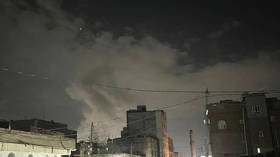WATCH: Horde of locusts blocks out the skies in Saudi Arabia, Yemen
Residents in Saudi Arabia and Yemen have been faced with the bewildering sight of a truly gargantuan swarm of roughly 360 billion locusts, which can block out the sun at times. But an even bigger swarm is coming soon.
The massive locust swarm measures roughly the size of Manhattan and has caused tens of millions of dollars worth of damage, devastating East Africa in one of the worst outbreaks in decades.
جراد جراد جراد... pic.twitter.com/jdqZld7I0G
— مناضل (@Maneb35) February 2, 2020
Horde of locusts swarm #SaudiArabia, many more insects yet to comeSTORY: https://t.co/QN1fttU7z8pic.twitter.com/rU1bLMRApG
— RT (@RT_com) February 4, 2020
#نجران__الان#جراد الشرفه pic.twitter.com/Hqo2DphRjr
— اليامي (@kiing_88) February 2, 2020
The Food and Agriculture Organisation (FAO) of the United Nations has requested over $75 million to tackle the emerging crisis caused by the swarm. The insect outbreak was itself triggered by a series of recent cyclones, which produced ideal breeding conditions for the pests.
Saudi Arabia’s Ministry of Environment has warned residents not to eat any of the locusts as they are likely contaminated with toxic pesticides.
جانب من أعمال إدارة الصحة العامة بوكالة الخدمات ، للحد من التلوث ومكافحة الحشرات ، داخل المدينة.#أمانة_منطقة_نجرانpic.twitter.com/4NuMkMMklN
— أمانة منطقة نجران (@NajranMunicipal) May 5, 2019
Desert locusts consume their own bodyweight in food each day, and can travel up to 150km in swarms large enough to block out the sun.
“A swarm the size of Rome can eat enough food in one day as everybody in Kenya," said Keith Cressman, FAO’s senior agriculture officer.
To make matters even worse, another, even larger swarm is expected in April, which could grow up to 500 times in size by June.
Also on rt.com Huge swarm of grasshoppers splatter plane cockpit, force pilots to abandon landing and divert (PHOTOS)Think your friends would be interested? Share this story!















